
VOICE Home Page: http://www.os2voice.org
[Newsletter Index]
[Previous Page] [Next Page]
[Feature Index]

VOICE Home Page: http://www.os2voice.org |
July 2002
[Newsletter Index]
|
| By Eric Baerwaldt © July 2002, Translation: Philhard Ackermann |
Given the fact that Partition Magic from PowerQuest has lacked HPFS support since release 7.0 and that they have even removed the IBM bootmanager from their software package, we'll deal in more detail today with some other companies' products that offer features similar to what Partition Magic does.
After intensive research and testing I would like to introduce some small tools that are either free or somewhat cheaper than the products from PowerQuest yet still feature HPFS support. Please note though that you should by all means backup your data before you start using any of the tools mentioned in this article, because of the danger of data losses!
Well, let's get to those tools now:
VGA-Dupe v.2.03 is a native DOS program which won't run in a DOS windows or fullscreen on OS/2 Warp. This means that you need to create a DOS boot disk before you can use it (please format a clean disk with FORMAT A: /S), where the VGA-Dupe ZIP archive is afterwards unzipped to. This ZIP-Archiv consists of two files only so that even a double density floppy will be enough to use the program.
After starting the program you get a simply designed DOS console mask:
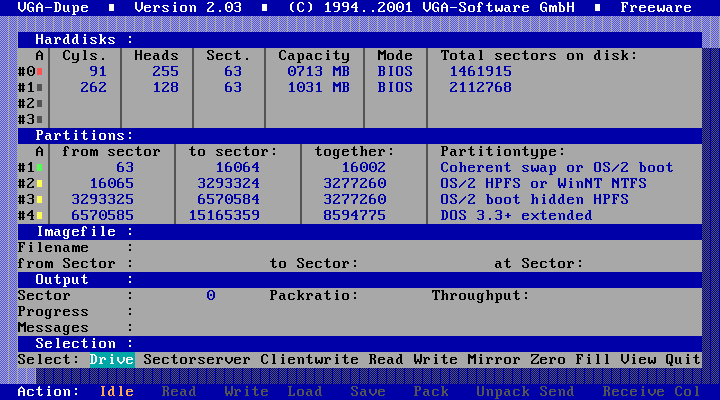
Abb.1: VGA-Dupe v.2.03 at work
VGA-Dupe recognizes every partition and also correctly shows their file systems. Of course it gets a little bit confused by the well-known restrictions the DOS operating system implies, and also when dealing with SCSI harddisks. As you can see in the image above it states the capacity of the first disk to be 0713 MB while in fact this disk's size is 9,1 GB. Still this little drawback doesn't spoil the usability of the program and the wrong capacity values shown can be safely ignored because VGA-Dupe recognizes your hard disk's partitions on a sector basis and shows them correctly in the second frame labelled Partitions.
The Imagefile frame right below is where you have to enter a name for the target image file. There should already be some DOS partition formatted with the FAT16 file system on your disk to which the program can copy the image file. Of course HPFS partitions are no valid targets and will not be accepted by the program. Naturally the drive letter for the image file will be C: if there's only one FAT16 partition available. Since the copy operation is carried out sector by sector it is also possible to enter starting and ending sectors manually thus only copying selected partitions to the target file, but beware: if the sector values entered don't exactly correspond to the values VGA-Dupe shows the resulting image will be rendered unusable!
VGA-Dupe then starts its copy operation after user's confirmation. When using VGA-Dupe you will soon realize that the program runs much slower than the DriveImage counterpart. VGA-Dupe also lacks some of the nicer features like password protection and SmartSector copying, and its compression algorithm turns out to be less efficient than that of the product from PowerQuest. What's more, it doesn't check the unit for errors before starting the copy operation.
Still you can get over those little disadvantages in comparison with the PowerQuest software if you consider that VGA-Dupe is free. If operated correctly the product does it's job very well and runs without any flaw.
Because of the aforementioned reasons IBM's bootmanager can only be considered second choice when you're dealing with operating systems other than OS/2 - there are better choices.
One alternative for those insisting on IBM's bootmanager might be using PartitionMagic 5.0x to partition their hard disks and then install bootmanager from PartitionMagic afterwards. In this release PartitionMagic already comes with BootMagic which supports most Windows derivatives and thus could be used instead of IBM's bootmanager. Still the combination of PartitionMagic and IBM's bootmanager should be an acceptable choice for OS/2 users if their harddisk is greater than 8 gig, because PartitionMagic could then be used to partition the disk correctly.
At this stage I would like to point out another alternative which should especially be interesting to those who need 4 primary partitions and have installed one single hard disk in their machines only.
Power Bootmanager in fact consists of two separate bootmanagers: the first one installs itself to the MBR (= Master Boot Record) of your harddisk so it doesn't need a dedicated primary partition. This one is very well suitable for those systems with only one harddisk that is destined to carry 4 primary partitions.
Alas this bootmanager's installation is anything but straightforward and is rendered even more complex by what the producers offer in the program's online documentation. At first an OS/2 user will have to create a floppy disk containing the appropriate system files. This means to generate a bootable DOS disk which also features all the drivers needed inside AUTOEXEC.BAT and CONFIG.SYS to access one's CDROM drive. Such a bootable DOS disk can't be made with OS/2 Warp, neither in a DOS window nor in DOS Fullscreen, so a native DOS partition is a must. Then, after a reboot of the system, a program called SETUP.EXE which is to be found on the bootmanager's CD has to be started, which will then lead the user through a menu-driven installation routine. The first thing it does is to overwrite our newly created bootable floppy disk with some other DOS system and some files needed for setting up the bootmanager are also copied to that disk.
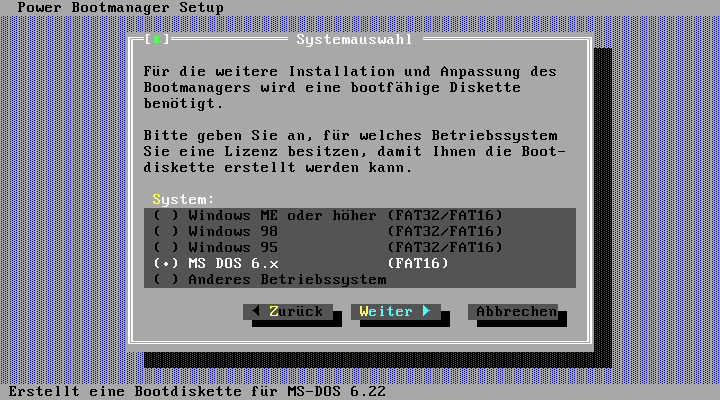
Abb.2: the creation of an "MS"-DOS bootdisk
Translation: "For the rest of the bootmanager's installation and customization
a bootable floppy disk is required."
"Please specify the OS you own a license for so that the emergency bootable
floppy disk can be created."
The aforementioned copy operation of those special setup files is absolutely necessary because MS-DOS won't recognize SCSI-CDROM drives and offers to install IDE support for CDROMs only, which will not work with SCSI-only machines.
After the creation of the bootable setup disk the bootmanager is started and configured by running a program named POWERMBM.EXE. At this point the program is incapable of recognizing the HPFS partition correctly while our IBM bootmanager partition is accurately detected.
The customization dialogue allows every partition to be selected for system boot and, optionally, to be password protected. All settings are then written to the MBR while offering to create an emergency floppy disk. This option should be chosen by all means, because if, in a worst case scenario, the MBR gets accidentally erased or we suffer from a virus infection, all data stored there will be destroyed beyond repair. But with the help of that emergency disk the MBR can easily be restored and so access to our data can be guaranteed.
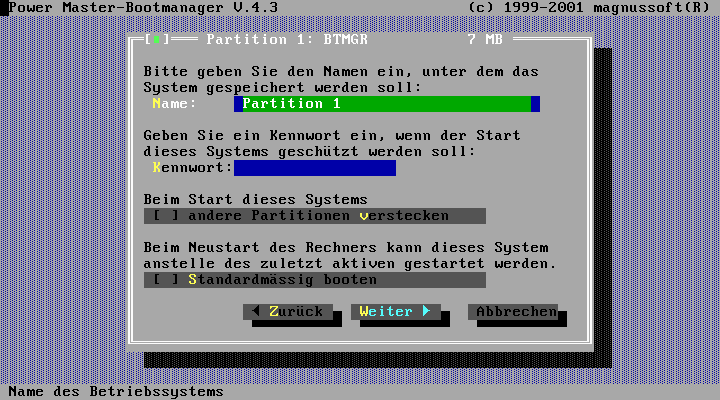
Abb.3: The bootmanager's customization dialogue
Translation:
"Please enter a name for the system to be saved"
"Please enter a password if this system's startup shall be protected"
"When starting this System [ ] hide other partitions"
"When starting the computer this system can be booted instead of the system
that had been active the last time [ ] boot by default"
If there are two or more hard disks in your machine, instead of running the power master bootmanager POWERMBM you'll have to install the power bootmanager POWERBM off that floppy disk, which in contradiction to the former of these two programs, strictly requires a primary FAT partition to be on the first physical hard disk.
POWERBM offers a customization dialogue quite similar to the one we've already seen, but contains some additional functions which primarily address the usage of several hard disks.
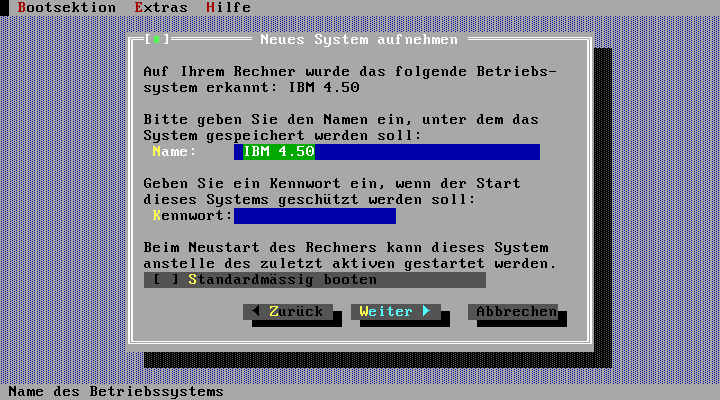
Abb.4: OS/2 WARP v.4.51 has been recognized as "IBM 4.50" here
By pressing <ALT-B>+<V> power bootmanager is made to prepare itself for the definition of another partition entry. After that the OS has to be installed. If there are already OSes on your disk they can be checked one by one. WIth the option "save MBR" we are given the opportunity to save the contents of the active MBR to a floppy disk before making any changes. This is strongly recommended!
After finishing the installation and a warm start we are presented with all our bootable partitions in a neat little window.
Conclusion: This pair of bootmanagers from Magnussoft is very well suitable for any need that may arise from any kind of hard disk configuration. For an amount of 15 EUR this product is well worth its price if you consider all those functions these bootmanagers have to offer. Still the quick installation manual needs to be revised and in favour of newbies the online documentation containing that naming chaos should be corrected and reworked.
Besides the usual functions for partitioning hard disks XFDisks's bootmanager is its best part. This no-frills bootmanager's functionality reaches far beyond anything IBM's bootmanager has to offer: It allows for up to 8 entries and each entry can be password protected. The bootmanager routine is stored inside the hard disk's MBR, so that in the majority of today's PCs which only sport a single hard disk no partition is lost to the bootmanager code. In addition XFDisk offers the possibility to alter a partition's type on the fly, so that you can, for example, create an HPFS partition out of a »Windows« VFAT partition just by the flick of a switch.
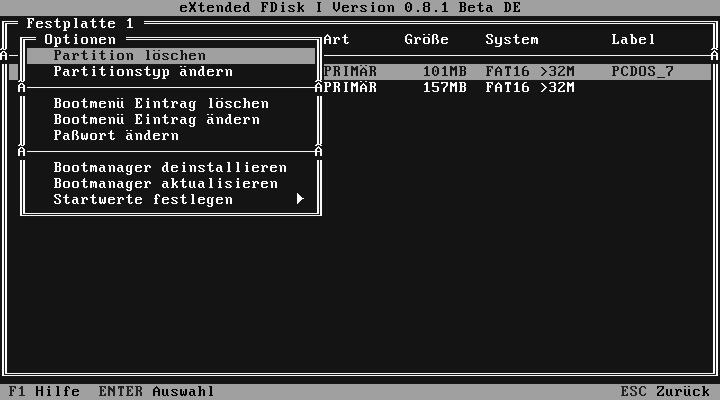
Abb.5: XFDisk
What's more the authors distribute have included a well designed and exhaustive documentation which enables even the less skilled users to achieve a somewhat detailed understanding of hard disk partitioning. Even basics are very well explained, so that this program's usage doesn't require special skill. Alas the documentation is in German only, so people from outside of German speaking areas who are unable to understand that language might have a problem to exploit XFDisk's functions and thus should rather refrain from using it because of the dangers it involves.
And there still are some problems with this beta release of XFDisk I'm not willing to conceal. The program has it's security issues: since its password protection can be evaded quite easily it is just no good. During my tests I had no problems to start an IBM PS/2 76i which ran XFDisk absolutely well, but besides that the password protection of the ED floppy disk drive just didn't function at all. After booting the machine with a PC DOS floppy disk nothing prevented me from accessing the first primary FAT partition, although this should also have been password protected (this only worked when it was started via the bootmanager). The problem could be reconstructed using an IBM ThinkPad 760 which also features an ED floppy disk drive. Another flaw showed up on an IBM PS/2 77s with two SCSI hard disks: here XFDisk couldn't be installed at all, even with a primary FAT partition on the first disk. When started, the program stopped loading and stated that neither a boot sector nor a partition table was to be found. Yet there were OS/2 WARP 3, eCS and two logical HPFS drives and a logical FAT drive on the first disk and OS/2 WARP v.4.51 on the second. A subsequent installation of IBMs bootmanager on that machine went absolutely fine. I even consulted all those tools the PartitionMagic package features, none of which reported anything special about the two hard disks. A »clean« PS/2 76i and a PC Server 720 with minimal equipment (a processor complex with two Pentium CPUs only) were accepting XFDisk without complaint during a clean install.
Conclusion: The XFDisk freeware program is a good choice for people planning
a clean install on a box with one hard disk only who probably don't need a password
protection. XFDisk runs stable. Its bootmanager isn't beefed up with a graphical
interface, but as a "Warper" we aren't used to something like that anyway,
so this should be something we can easily get over with. When compared to IBM's
bootmanager XFDisk has the advantage that it doesn't require a dedicated partition,
so for those needing four primary partitions on their hard disks it is a viable
solution.
References:
VGA-Dupe |
[Feature Index]
editor@os2voice.org
[Previous Page] [Newsletter Index] [Next Page]
VOICE Home Page: http://www.os2voice.org